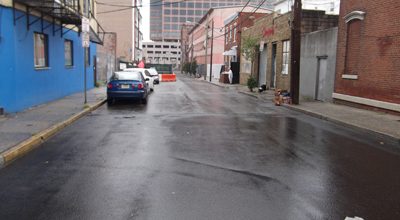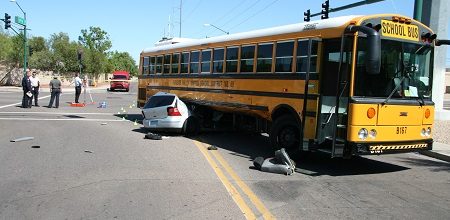National Bus Trader has always been a leader in its selection and treatment of topics related to technology and innovation. So the decision to craft a lengthy article about NBT Editor Larry Plachno’s experiences “behind-the-wheel” of a motorcoach-of-the-future at a “ZF Ride & Drive” event in Aachen, Germany (NBT, September, 2016) should not have been a surprise. Nor should it come as a surprise that safety, liability and other issues related to this technology will be explored as well. Prophesies and Paradigms Two years ago, Uber owner Travis Kalanick ‘s claim that its
Archives for National Bus Trader
Rounded Curbs and Limit Lines
Back in the day when I was pursuing my Masters in Urban and Regional Planning, one of the first lessons we learned was that America is the “car country.” While this reality vexed academics and public transportation aficionados, it was quite popular at the voting booth. We also learned that the Defense Highway Act of 1956 had little to do with defense, and the Home Loan Mortgage Insurance Act of the same period had little to do with homes. Instead, both had a lot to do with cars. Before these regulations took hold, our non-farm population was largely concentrated in
Dancing in the Oncoming Lane: Long Wheelbases and Right Turns
A few months ago, in “The Danger Deterrent” (National Bus Trader, April, 2016), I explored the unsettling dangers associated with vehicles with long wheelbases making left turns. In that article, I mentioned having served as an expert witness in at least two-dozen left-turn-related lawsuits. Yet I have never been involved in a case involving a right turn. Superficially, one could only wonder why, since the “rock-and-rolling” necessary to view around otherwise blind spots in order to turn right is far greater than that needed to turn left. Plus, most of the victims of left-turning accidents are visible directly through the
The Case for Mandatory Sleep Apnea Testing, Part 3: The Need for Universal Testing and Treatment
In Part 1 of this series, we learned that an eye-opening study of 517 Australian truck drivers found that 45% of them possessed Obstructive Sleep Apnea (OSA) — while only four of those 45% knew of it before being tested for it. We learned that the criteria for “screening” to identify those likely to have OSA likely catches most of them, but hardly all of them. We learned that, currently, FMCSA regulations govern only one aspect of driver fatigue (the duration of the shift), while the Administration recently issued an Advanced Notice of Proposed Rulemaking (APRM) only for OSA “screening”
The Case for Mandatory Sleep Apnea Testing, Part 2: The Weaknesses of Screening
Nothing could better illustrate the folly of OSA screening than the fact that my own OSA status literally changed between my authorship of Part 1 of this series and this installment. In the hope of finding an honest and competent sleep doctor willing to tweak my OSA treatment machine, the excellent specialist I finally saw determined that I did not have OSA at all. Instead, the heavy medication I take to merely fall asleep was effectively closing my airways such that the results of the study I underwent in a sleep lab suggested I had OSA but did not –
The Case for Mandatory Sleep Apnea Testing, Part 1: An Overview
A few years ago, an Australian study of 517 long-distance truck drivers found that an additional 41 percent of them possessed Obstructive Sleep Apnea (OSA) — a disorder estimated to affect only four to six percent of the general population. (4.4% of these drivers had previously acknowledged having been diagnosed with this disorder.) Few of the individuals with this disorder were identified by the “multivariable apnea prediction index, based on self-report measures.” Otherwise, among the Aussies evaluated, 50% were obese. And 49% smoked cigarettes. (SLEEP; journalsleeo.org). The latter of these characteristics is not even considered among the naive handful of
The Danger Deterrent: Long Wheelbases and Left Turns
Like most fields, public transportation is swollen with studies, both in the U.S. and abroad. Yet some of the most fascinating things seem to be never studied, or rarely studied. One example of this phenomenon comes from my experience examining more than 80 incidents involving vehicle-pedestrian and vehicle-vehicle incidents. Many of them involved buses or coaches turning. I learned many unique things from these incidents. Yet some things are still puzzling. One of them is the dozens of incidents that involved buses, motorcoaches or van- and minibus-conversions (to accessible vehicles) making left turns. Yet I cannot recall a single
Whatever Happened to Seat Compartmentalization
In the late 1970s, in response to another fatality accident (the trigger for safety-related innovation in America), the National Highway Traffic Safety Administration (NHTSA) mandated the installation of compartmentalized seating in school buses of every type and size. Compartmentalized seating is a controlled response to the free-flight characteristics of an unbelted passenger when inertial and centrifugal forces are exerted on his or her body. When a passenger flies forward (e.g., from a head-on collision), the torso generally collides with the seat back in front, usually in a knee-torso-head-impact sequence. Compartmentalized seats control this movement through variations in the density of
Bad Regulations and Worse Responses Part 7: Conclusions
This final installment of this series provides the rewards for reading the first six: Starting-point ideas about things the motorcoach industry can do defend its density against intrusion from Transportation Network Companies (like Uber, Lyft and Sidecar), which have already begun plunging into the charter and tour sectors, mostly with medium-sized, body-on-chassis vehicles. It also includes things that would help increase profits and create new service opportunities – and compete with new, legitimate players penetrating the market. In stating this, my research into TNCs, and particularly my experience attending the last BusCon Conference and reviewing a year’s worth of Limousine,
Bad Regulations and Worse Responses, Part 6: Industry and Association Responses
As NATIONAL BUS TRADER readers following this series have noted, our judicial system seems to be “running the table” with TNC-related issues. The $220,000,000 settlement of a case against FEDEX effectively eliminated the notion of an “independent contractor” in its six states. And the California courts are soon likely to boot out Uber. The FEDEX case in the U.S. Court’s 10th Circuit effectively rippled a TNC’s ability to deprive its drivers of a regular employee’s costly array of fringe benefits. This settlement is likely to soon play out in the other nine “Circuit” encompassing the other 44 states. And if




